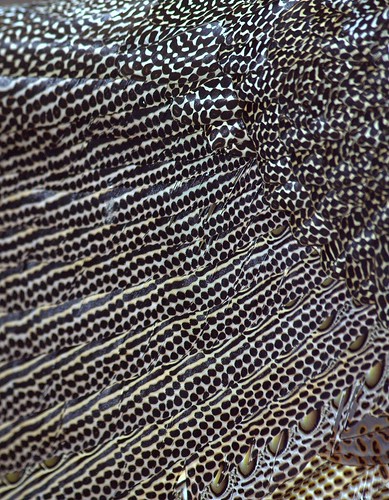tags: Great Argus Pheasant, Great Argus, Phoenix, Argusianus argus, birds, mystery bird, bird ID quiz
[Mystery bird] Great Argus Pheasant, also known as the Great Argus or the Phoenix, Argusianus argus, endemic to Malaya, Sumatra, and Borneo. [I will identify this bird for you in 48 hours]
Image: John del Rio, 2009 [larger view].
More images by this photographer can be seen on the front page and in the gallery.
Nikon D200, Kowa 883 telescope with TSN-PZ camera eyepiece 1/800s f/8.0 at 1000.0mm iso400.
Please name at least one field mark that supports your identification.
The scientific name of the Great Argus was given by Carolus Linnaeus in reference to the many eyes-like pattern on its wings. Argus is a hundred-eyed giant in Greek mythology.


Wow! First thought was a species of guineafowl from the family Numididae, but they are all endemic to Africa, so perhaps I have to look to an Asian member of the Phasianidae?
The barely seen 'eyespots' on the feathers are what tipped me off. I believe its an Argus Pheasant, Argusianus argus.
LOL! Got it, but for fear of nixing this before it even starts, I will have to step back a little... any play on words with either the genus or species names will give it away too easily!
It's a good thing though that dogs, just like Odysseus' dog, have that sixth sense and can act as "centurions"!
hrmph, if zoo hadn't given it away so soon I would have enjoyed delving into Greek mythology again!
Odysseus's dog was called Argos but I don't get the centurion clue! Has this any connection to Jason and the Argonauts? David?
Maggie,
You are correct, Odysseus' dog was indeed named Argos who waited for the entire duration of the Trojan War for his master to return. Odysseus did indeed return (according to Book 17 of Homer's Odyssey), but in disguise as a beggar, however Argos recognised him after 20 years (my "sixth sense" hint) and being thus satisfied at his master's return, died.
Argos was also the name of the shipbuilder who built the Argo for Jason (the Greek á¼ÏÎ³Ï means "fast") on his quest for the Golden Fleece, as written by Apollonius Rhodius in his Argonautica.
Finally, "centurion" refers to the hundred eyes of Argos (Panoptes) who was given the duty to guard Io and who was always able to keep more than one eye open; according to Hesiod in his Aigimios, in celebration for his duty, Argos was eventually turned into a "peacock" by his mistress, Hera.
Now I do happen to think it is indeed a Great Argus, Argusianus argus, but except for the fact that Grrl notes this particular bird is endemic to Sumatra and Borneo, I can't find any evidence to demonstrate that it couldn't be a Crested Argus, Rheinardia ocellata, the nigrescens subspecies of which could also be found on peninsular Malaya...
I don't know where exactly the photographer took this shot, but if on peninsular Malaya or Sumatra, this would be the nominate subspecies A. a. argus, but if on Borneo, A. a. grayi.
Thanks so much David! I loved the Odyssey and the Iliad! Now it all makes sense- the centurion as Argus the hundred-eyed giant guarding Io and as Argus the dog guarding Ulysses's house. Is this the same as the phoenix?
Mantanani Scops-Owl?
Ah! There is indeed some connection between the Argus and the Phoenix, where some records show that the Chinese bird know as Feng-huang was probably the second bird I referenced above, the Crested Argus or Ocellated Pheasant, while the bird know as Luan is the one we have here, the Great Argus or Argus Pheasant. I believe that in Western literature, both Chinese birds were assumed to be the Phoenix.
Perhaps you should consult with Ms. Bennu (aka Grrl!) whose name is the ancient Egyptian version of the same!
Grrl?
I go out for the day and come back to a solved MB. Perhaps David can tell me why one of the local (Bradford) papers is called the Telegraph and Argus. Just asking.
LOL Adrian!
Perhaps because it is partly produced in India and there is a strong Phaesianidae connection there with multiple species of pheasant, tragopan, monal, partridge, and of course peafowl?
Interestingly it is ultimately owned by Gannett, and it's current editor is Peregrine!
Actually, I think that the name was chosen (as with other city/area newspapers like in South Wales, Brighton, Dundalk, Seattle, Melbourne) because of the "hundred eyes" connotation- a paper that sees everything can report everything.
Thanks David, the 100 eyes is right! BTW the picture above shows the elongated secondary feathers of the bird, not the coverts as would be expected.
David, how the heck...??!!
The "ball in socket" feather markings in the lower part of the photo are unmistakable: it is the Great Argus, which Darwin wrote about in The Descent of Man.